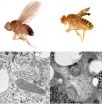(Press-News.org) Strengthening routine influenza vaccination and health programs may help states improve their vaccination coverage against future pandemics or other health emergencies, a new study suggests.
The study -- conducted by researchers at the Georgia Institute of Technology in collaboration with the Centers for Disease Control and Prevention (CDC) -- examined factors that may have contributed to the striking state-by-state variation in U.S. H1N1 flu vaccination rates. The results of the study were revealed on Oct. 26 at the 32nd Annual Meeting of the Society for Medical Decision Making.
"Health officials in states that reported lower H1N1 vaccination rates should learn from states with high vaccination rates during the 2009 event to increase their rates during the next pandemic or significant health emergency," said Julie Swann, an associate professor in Georgia Tech's H. Milton Stewart School of Industrial and Systems Engineering. Swann also held a joint appointment at the CDC for six months last year through its Preparedness Modeling Unit.
CDC Immunization Services Division Branch Chief Pascale Wortley and Georgia Tech graduate student Carlo Davila Payan worked with Swann on this project.
Among American adults, H1N1 vaccine coverage ranged from a high of 34 percent in South Dakota to a low of nine percent in Mississippi. The research team found that states with higher past seasonal influenza vaccination coverage or use of other preventive health services in adults showed higher 2009 H1N1 vaccination rates.
"These findings suggest that an increase in health-seeking behavior may increase vaccination rates during a pandemic," noted Swann. "If we could encourage more adults to be vaccinated against flu each year, we might have more success in protecting them from the next pandemic."
Lower adult H1N1 vaccination coverage was observed in states where the disease circulated for a long period of time. That might have occurred because if someone in a household already had influenza, others in the household did not feel the need to get vaccinated, explained Swann.
In terms of supply chain factors, vaccination coverage was lower in states where more time was required to order allocated doses. The team noted that time lags in the system may be a function of efficiency or differences in system processes across states, suggesting monitoring and potential system design changes.
For high-risk adults -- those with underlying medical conditions that make them more susceptible to severe outcomes from influenza infection -- coverage ranged from 10 to 47 percent across the country. While the yearly acceptance of seasonal flu vaccination affected the likelihood of H1N1 vaccination for this group as well, the study found that states with a large percentage of individuals medically underserved by health professionals showed lower coverage for H1N1 immunization.
"This shows that the public health issues such as not having enough primary care providers or having high poverty in an area not only have an impact on daily primary care, but also emergency pandemic care as well," said Swann.
Among children aged six months to 17 years, vaccine coverage ranged from a high of 85 percent in Rhode Island to a low of 21 percent in Georgia. In this group, the researchers found that states with a higher percentage of children showed lower vaccination coverage. Conversely, a focus on school vaccination or a high number of doses sent to or administered in public access areas positively impacted the H1N1 vaccine coverage.
"Accounting for the relative size of a state's child population in allocating vaccine could improve vaccination coverage of children, in a scenario where children are targeted, especially if children of some ages require two doses of the vaccine, which was the case with the H1N1 vaccine," said Swann.
In terms of supply chain factors, vaccination for children was associated positively with the number of shipments per location. According to the research team, repeated distribution to the same sites could represent underlying system differences related to the efficiency of those states, the use of school vaccination programs or their ability to monitor vaccine use and redistribute to providers who were vaccinating quickly.
In this study, the researchers were able to explain more than 75 percent of the variation in state-specific vaccination coverage of adults or children with regression models that included only statistically significant variables.
Some of the state-specific data that the research team collected in their search for factors that influenced H1N1 vaccination coverage included:
Demographic data -- e.g. race, education level and income
State and government data -- e.g. number of counties and federal dollars per capita
Health indicators -- e.g. seasonal flu vaccination rates and number of healthcare providers
H1N1 surveys -- e.g. how the vaccine was allocated (by the state or locally) and the availability of doses in public settings
CDC allocation and shipment data -- e.g. number of vaccination sites and peak week of Influenza-like illness activity
While the study found relevant factors, the researchers note that the recommendations of the study are based on data collected during a vaccine shortage situation and may not apply to a non-shortage situation. In addition, even though the team collected as much data as they could on state infrastructures and decision-making processes, complete data from every state was not available.
"Ultimately, the study suggests factors that public health agencies might consider monitoring in an emergency vaccination program with limited vaccine supply, and several other aspects public health systems could consider when designing systems," added Swann.
INFORMATION:
Strengthening routine flu vaccination and health programs may improve pandemic vaccinations
2010-11-03
ELSE PRESS RELEASES FROM THIS DATE:
GOES-13 catches Tropical Storm Tomas' early morning strengthening
2010-11-03
The GOES-13 satellite keeps a continuous eye on the eastern half of the U.S. and Atlantic Ocean basin, and has provided meteorologists with an infrared look at a strengthening Tropical Storm Tomas this morning.
The Geostationary Operational Environmental Satellites like GOES-13 are managed by NOAA. The NASA GOES Project at NASA's Goddard Space Flight Center in Greenbelt, Md. creates images and animations from the GOES satellite data. When GOES-13 provided an infrared image (because it was taken at night) today, Nov. 2 at 0845 UTC (4:45 a.m. EDT), Tropical Storm Tomas ...
NJIT math professor illuminates cellular basis of neural impulse transmission
2010-11-03
NJIT Associate Professor Victor Matveev, PhD, in the department of mathematical sciences, was part of a research team that published "N-type Ca2+ channels carry the largest current: Implications for nanodomains and transmitter release," in Nature Neuroscience on Oct. 17, 2010. http://www.nature.com/neuro/journal/v13/n11/abs/nn.2657.html
Leading the project, Elise Stanley, PhD, a senior scientist at the Toronto Western Research Institute, said that Matveev's mathematical modeling showed that calcium influx through a single N-type calcium channel is sufficient to trigger ...
Improving health care in the Internet age
2010-11-03
Faster and more widely available internet access has improved our lives in many ways but healthcare is lagging behind, according to researchers writing in the International Journal of Medical Engineering and Informatics.
The US team suggests that there is immense potential for the utilization of digitized personal health records (PHR) in chronic disease management. They have reviewed the state of the art in healthcare portals, assessed the standardization and the legality of health record s and point to a need to improve interoperability, which still represents a major ...
New study re-examines bacterial vaccine studies conducted during 1918 influenza pandemic
2010-11-03
WHAT:
Secondary infections with bacteria such as Streptococcus pneumoniae, which causes pneumonia, were a major cause of death during the 1918 flu pandemic and may be important in modern pandemics as well, according to a new article in the Journal of Infectious Diseases co-authored by David M. Morens, M.D., senior advisor to the director of the National Institute of Allergy and Infectious Diseases, part of the National Institutes of Health.
The researchers examined 13 studies published between 1918 and 1920. During this time, many scientists erroneously believed that ...
Gastric bypass alters sweet taste function
2010-11-03
Gastric bypass surgery decreases the preference for sweet-tasting substances in obese rats, a study finding that could help in developing safer treatments for the morbidly obese, according to Penn State College of Medicine researchers.
"Roux-en-Y gastric bypass surgery is the most common effective treatment for morbid obesity," said Andras Hajnal, M.D., Ph.D., associate professor, Department of Neural and Behavioral Science and Surgery. "Many patients report altered taste preferences after having the procedure."
This surgery involves the creation of a small gastric ...
The Scientist's Life Science Salary Survey 2010 -- results announced
2010-11-03
This year's Salary Survey saw drops in salaries across the board with almost every speciality suffering a setback, some with dips as large as $20,000 (ecology) and $28,000 (virology).
However, a few select fields, namely bioinformatics, biophysics, biotechnology, and neuroscience, bucked the trend and actually posted salary increases this year. Whilst it is not easy to determine why these specialities saw salaries rise and others saw salaries cut, Mark Musen, head of the Stanford Center for Biomedical Informatics Research at Stanford University commented: "I've noticed ...
Antibody locks up West Nile's infection mechanism
2010-11-03
WEST LAFAYETTE, Ind. - Researchers have learned the structure that results when an antibody binds to the West Nile virus, neutralizing the virus by locking up its infection mechanism. The information could help scientists develop a vaccine against the mosquito-borne disease.
The findings show precisely how a key part of the antibody, called the antigen binding fragment, or Fab, attaches to two adjacent protein molecules that make up the virus's outer shell. This "crosslinking" attachment between molecules is repeated over the entire shell, interlocking the 30 molecular ...
Daily dose of beet juice promotes brain health in older adults
2010-11-03
Winston-Salem, N.C. – Researchers for the first time have shown that drinking beet juice can increase blood flow to the brain in older adults – a finding that could hold great potential for combating the progression of dementia.
The research findings are available online in Nitric Oxide: Biology and Chemistry, the peer-reviewed journal of the Nitric Oxide Society and will be available in print soon. (Read the abstract.)
"There have been several very high-profile studies showing that drinking beet juice can lower blood pressure, but we wanted to show that drinking beet ...
Severely injured should go directly to trauma center: Research
2010-11-03
TORONTO, Ont., Nov. 2, 2010-Severely injured patients should be transported directly from the scene of an accident to a trauma center, even if it means bypassing a closer hospital, according to new research that shows this results in a nearly 25 per cent lower death rate.
However, even though 80 to 85 per cent of people in North America live within a one-hour drive or flight of a trauma center, 30 to 60 per cent of severely injured patients are still taken to the nearest hospital.
Researchers led by Dr. Avery Nathens, trauma director at St. Michael's Hospital in Toronto, ...
Scientists at IRB Barcelona discover a new protein critical for mitochondria
2010-11-03
A study by the team headed by Lluís Ribas de Pouplana, ICREA professor at the Institute for Research in Biomedicine (IRB Barcelona), has been chosen as "Paper of the week" in the December issue of the Journal of Biological Chemistry, which is already available online. The article describes the discovery of a new protein in the fly Drosophila melanogaster (fruit fly) that is crucial for mitochondria. The removal of SLIMP in these flies leads to aberrant mitochondria and loss of metabolic capacity, thus causing death.
The study, whose first author is Tanit Guitart, a PhD ...


